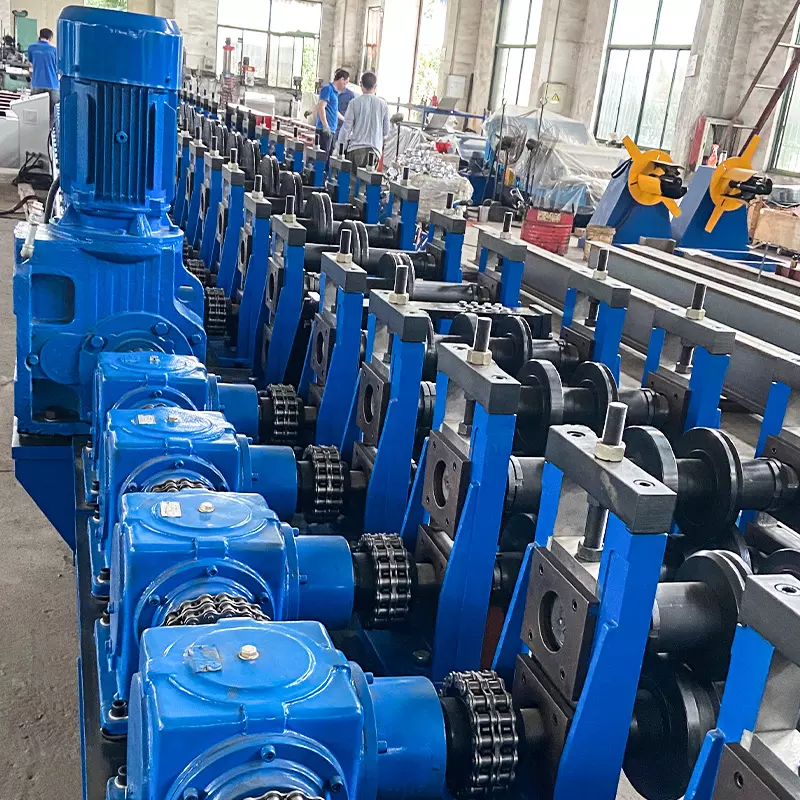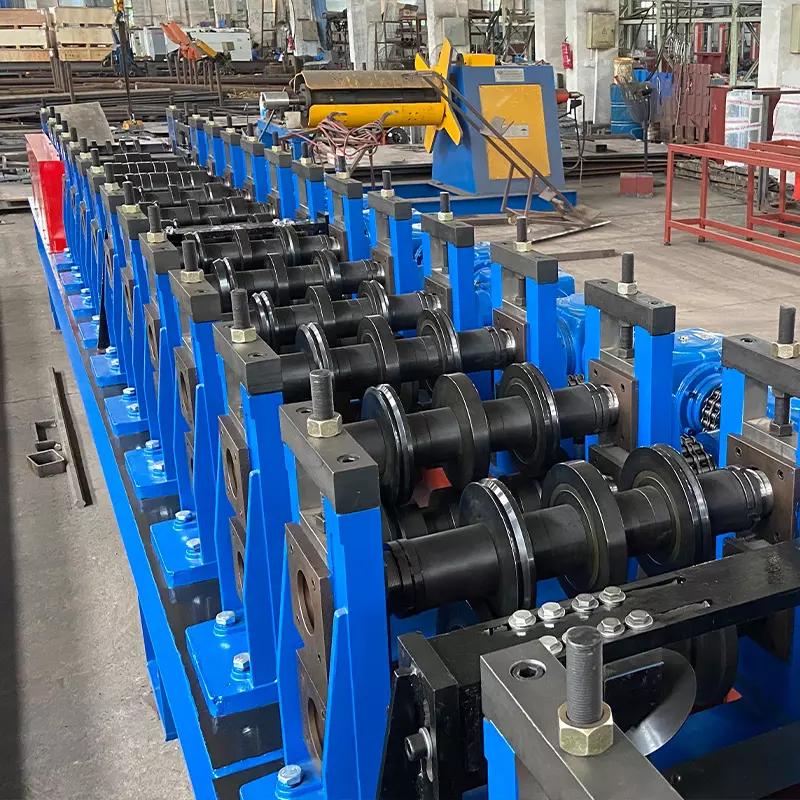Overview of Roll Forming Equipment
Roll forming equipment is a high-precision metalworking system that continuously shapes metal sheets or coils into specific profiles using a series of rollers. Unlike stamping or press braking, roll forming is a continuous process, making it ideal for high-volume production with minimal material waste.
Industries such as construction, automotive, aerospace, racking & shelving, and renewable energy rely on roll forming equipment for cost-effective, durable, and precisely shaped metal components.
Key Benefits of Roll Forming Equipment
✅ High-speed production – Continuous operation increases efficiency.
✅ Minimal waste – Reduces material loss compared to stamping.
✅ Superior finish – Produces smooth, uniform profiles.
✅ Cost-effective – Lowers production costs over time.
✅ Highly automated – Supports CNC and AI integration for accuracy.
This guide will cover:
✅ How roll forming equipment works
✅ রোল তৈরির মেশিনের প্রকারভেদ
✅ Advantages of roll forming vs. other metal forming methods
✅ Best materials for roll forming
✅ Applications in different industries
✅ How to choose the right roll forming equipment
Let’s dive in!
How Does Roll Forming Equipment Work?
Roll forming works by gradually bending metal sheets through a series of rollers until the final shape is achieved. Unlike stamping or extrusion, roll forming equipment does not require excessive force or heat, making it highly energy-efficient.
Step-by-Step Breakdown of the Roll Forming Process
| Step | Description |
|---|---|
| 1. Coil Loading | A metal coil is placed on the decoiler, feeding the material into the roll forming system. |
| 2. Leveling & Guiding | The sheet passes through a leveling unit to remove any irregularities. |
| 3. Roll Forming Stages | A series of rollers gradually shape the metal into the desired profile. |
| 4. Cutting & Punching | ক hydraulic or servo-driven cutting system trims the profile to the required length. |
| 5. Final Product Collection | The finished product exits the machine and is stacked or transported for further use. |
Did you know? Roll forming machines can operate at speeds of 10-100 meters per minute, making them highly efficient for mass production!
Types of Roll Forming Equipment
Different industries require various types of roll forming machines based on profile complexity, material thickness, and production volume.
Common Types of Roll Forming Machines
| Machine Type | বৈশিষ্ট্য | Best For |
|---|---|---|
| Single Profile Roll Forming Machine | Produces one specific profile | Roofing sheets, wall panels |
| Multi-Profile Roll Forming Machine | Can adjust to create different profiles | Racking & shelving, metal framing |
| CNC-Controlled Roll Forming Machine | Uses computer control for high precision | Automotive and aerospace industries |
| Portable Roll Forming Machine | Compact and mobile for on-site use | On-site construction projects |
| High-Speed Roll Forming Machine | Designed for mass production | Large-scale manufacturing |
WUXI SUNWAY MACHINERY CO., LTD specializes in customized roll forming equipment, offering high precision, durability, and efficiency for various industrial applications.
Roll Forming vs. Other Metal Forming Methods
Choosing the right metal forming process depends on production speed, material waste, and cost efficiency.
Comparison Between Roll Forming and Other Metal Forming Methods
| Feature | রোল গঠন | Stamping | Press Braking | Extrusion |
|---|---|---|---|---|
| Process Type | Continuous rolling | Punching and shaping | Bending sheets with a press | Pushing material through a die |
| Production Speed | High-speed | Faster for small parts | Slower, batch-based | Medium-speed |
| Material Waste | Minimal waste | Higher material scrap | Higher material waste | Minimal |
| Best For | Long, continuous profiles | Small, intricate parts | Custom short-run parts | Hollow sections and tubes |
| Energy Consumption | Low | Medium | High | High |
Verdict: Roll forming is the best choice for continuous, high-volume production with minimal material waste.
Best Materials for Roll Forming Equipment
The type of metal used in roll forming depends on the application requirements, including strength, durability, and corrosion resistance.
Common Materials Used in Roll Forming
| Material | Properties | Common Applications |
|---|---|---|
| Galvanized Steel | Corrosion-resistant, durable | Roofing, wall panels, HVAC ducts |
| Stainless Steel | High strength, rust-resistant | Automotive, medical equipment |
| Cold Rolled Steel (CRS) | Smooth surface, strong | Industrial shelving, construction beams |
| Aluminum | Lightweight, flexible, corrosion-resistant | Solar mounting brackets, window frames |
| Copper | Excellent conductivity, aesthetic appeal | Electrical components, decorative trims |
Sunway Machine provides custom roll forming solutions for specialized materials like solar mounting brackets, which require high strength and precision.
Industries Using Roll Forming Equipment
Roll forming equipment is essential across various industries for producing high-strength, lightweight, and precisely shaped components.
Key Industries Benefiting from Roll Forming Equipment
| Industry | আবেদন | Example Products |
|---|---|---|
| Construction | Roofing, wall panels | Metal cladding, C & Z purlins |
| Automotive | Structural components | Chassis parts, door beams |
| রাকিং এবং শেল্ভিং | Storage solutions | Warehouse racks, supermarket shelves |
| Renewable Energy | Solar panel mounting systems | PV mounting brackets |
| HVAC | Air duct systems | Ventilation ducts, support channels |
Sunway Machine specializes in roll forming machines for racking & shelving, solar energy, and steel structures, ensuring high precision and durability.

Choosing the Right Roll Forming Equipment
Selecting the right roll forming equipment requires careful evaluation of production needs, material compatibility, and automation level.
Key Factors to Consider When Buying Roll Forming Equipment
| Factor | Importance |
|---|---|
| Production Volume | Choose a machine that meets your output needs. |
| Material Type | Ensure the machine can handle the required metal thickness. |
| Profile Complexity | Simple vs. multi-profile machines. |
| Automation Level | CNC and AI integration for high efficiency. |
| Budget & ROI | Consider long-term savings from reduced waste and labor costs. |
| Manufacturer Reputation | Work with a trusted brand like Sunway Machine. |
Pro Tip: Investing in high-quality roll forming equipment ensures long-term savings and minimal downtime.
Common Problems & Solutions in Roll Forming Equipment
Even high-quality roll forming equipment can experience technical issues during operation. Identifying and resolving these problems early can minimize downtime and improve efficiency.
Troubleshooting Guide for Roll Forming Equipment
| Issue | Possible Cause | Solution |
|---|---|---|
| Profile distortion or incorrect shape | Misaligned rollers or incorrect pressure settings | Adjust roller alignment and ensure even pressure distribution |
| Inconsistent cutting length | Faulty hydraulic or servo cutting system | Inspect and calibrate the cutting mechanism |
| Material slippage during forming | Loose feeder rollers or improper tension | Tighten feeder rollers and adjust material tension |
| Excessive machine vibration | Loose machine components or unstable foundation | Tighten bolts and ensure the machine is installed on a stable surface |
| Uneven coating on galvanized steel | Incorrect roller pressure or improper feeding speed | Adjust roller pressure and speed settings |
Pro Tip: Conduct regular inspections and lubrication to prevent unexpected breakdowns and extend the lifespan of your roll forming equipment.
Future Trends in Roll Forming Equipment
The roll forming industry is evolving rapidly with advanced technologies that improve efficiency, precision, and sustainability.
Top Trends in Roll Forming for 2025
1. AI-Powered Predictive Maintenance
- AI-powered sensors detect machine wear and tear before failures happen.
- Reduces unexpected downtime and improves machine efficiency.
2. Eco-Friendly & Energy-Efficient Machines
- Newer machines are designed to consume less power, reducing operational costs.
- Sustainable materials like recycled steel and aluminum are being used more frequently.
3. Smart Factories & IoT Integration
- Machines now feature remote monitoring, allowing real-time production tracking.
- Data-driven analytics help optimize production schedules and reduce waste.
Keeping up with these trends ensures better profitability and competitiveness in the metal fabrication industry!
Roll Forming vs. Sheet Metal Stamping: Which is Better?
Many manufacturers choose between roll forming and sheet metal stamping based on production volume, material waste, and cost efficiency.
Comparison Between Roll Forming and Sheet Metal Stamping
| Feature | রোল গঠন | Sheet Metal Stamping |
|---|---|---|
| Process Type | Continuous shaping | Punching and pressing metal sheets |
| Production Speed | Faster for long, continuous profiles | Fast for small, repetitive parts |
| Material Waste | Minimal waste | Higher material scrap |
| Setup & Tooling Costs | Higher initial cost, lower long-term cost | Lower initial cost, higher long-term cost |
| Best For | Roofing sheets, solar brackets, shelving | Small, intricate metal parts |
Verdict: If you require continuous profiles at high speed with minimal waste, roll forming is the better choice.

Automation in Roll Forming Equipment
Roll forming machines are increasingly using automation and robotics to optimize performance and reduce labor costs.
Key Benefits of Automated Roll Forming
| Feature | Benefit |
|---|---|
| CNC Control Systems | Ensures precise measurements and minimizes human error |
| AI-Based Quality Inspection | Detects defects in real-time, reducing waste |
| IoT & Remote Monitoring | Allows operators to track machine performance from anywhere |
| Automated Profile Changeover | Reduces downtime when switching between profiles |
| Energy Efficiency | Optimized power consumption lowers operational costs |
Automation reduces production costs by up to 30% while improving product consistency!
Sunway Machine offers fully automated roll forming equipment, designed for smart manufacturing and Industry 4.0 compliance.
Maintenance Tips for Roll Forming Equipment
Regular maintenance is essential to keep your roll forming machine running efficiently and prevent costly breakdowns.
Essential Maintenance Checklist
| Task | Frequency | Purpose |
|---|---|---|
| Lubricate Rollers & Bearings | Weekly | Prevents wear and tear |
| Check Roller Alignment | Monthly | Ensures accurate profile production |
| Inspect Cutting Mechanism | Quarterly | Prevents defective cuts |
| Clean Machine Components | Daily | Removes dust and debris |
| Replace Worn Rollers | As needed | Maintains profile precision |
Pro Tip: A well-maintained machine can last 10-20 years or more, reducing long-term costs.
FAQ: Roll Forming Equipment
1. How long does it take to set up roll forming equipment?
Setup time varies, but with quick-change tooling, it can take as little as 30 minutes.
2. Can roll forming machines be customized?
Yes! Sunway Machine offers custom roll forming machines tailored to specific profiles and materials.
3. What industries benefit most from roll forming?
Industries like construction, automotive, racking & shelving, and renewable energy rely on roll forming for cost-effective, high-precision metal profiles.
4. How does roll forming compare to extrusion?
✅ রোল গঠন is best for thin sheet metal and continuous profiles.
✅ Extrusion is ideal for thicker materials like aluminum and plastic.
5. Where can I buy high-quality roll forming equipment?
For top-tier roll forming machines, visit WUXI SUNWAY MACHINERY CO., LTD.
Final Thoughts
দ্য roll forming process is essential for high-speed, cost-effective, and precise metal fabrication. Whether you’re in construction, automotive, or renewable energy, roll forming ensures high-quality results with minimal waste.
WUXI SUNWAY MACHINERY CO., LTD is a leading manufacturer of roll forming equipment, offering custom solutions, expert support, and competitive pricing.
Want to optimize your production? Contact us today!
